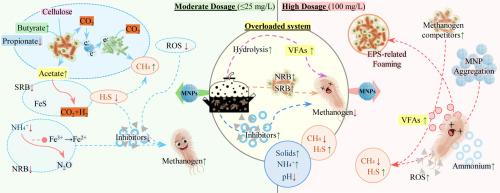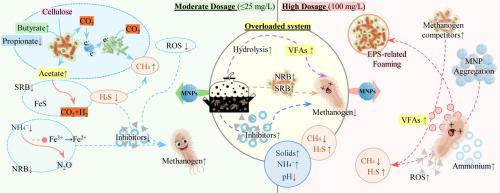减轻厌氧消化超载引起的应激:纳米磁铁矿添加剂的长期性能和命运
IF 12.4
1区 环境科学与生态学
Q1 ENGINEERING, ENVIRONMENTAL
引用次数: 0
摘要
厌氧消化(AD)被认为是一种有效的可持续废物管理和能源回收技术。然而,原料过载会促进挥发性脂肪酸(VFA)的积累、活性氧(ROS)的产生和泡沫的形成,从而破坏微生物的稳定性,导致甲烷产量降低和潜在的工艺故障。本研究研究了纳米磁铁矿颗粒(MNPs)在半连续AD操作下的长期应用,以减轻过载引起的应力。MNPs (20 nm和50 nm)应用于不同剂量(10-100 mg/L)和给药策略。适度添加(10-25 mg/L)显著改善了系统性能,与未经处理的超载系统相比,平均甲烷产量提高了8.6%,氢含量降低了27%,丙酸浓度降低了81.2%。饮食相关基因(如pilA)增加了27.4% - 36.5%,多用途产甲烷菌(Methanosarcina)的丰度增加了219.6%。相比之下,在平均pH为7.18的条件下,高剂量MNPs (100 mg/L)通过增加活性氧、铁溶解和纳米颗粒聚集(高达60%)诱导微生物应激,增加毒性和起泡风险。经济分析显示,25 mg/L 50 nm MNPs可将收益提高9倍,并将泥浆处理成本降低21.3%。然而,MNP的过量积累突出了谨慎控制剂量的必要性。该研究证明了MNP应用在恢复过载的AD系统中的潜力,并为纳米颗粒的长期行为提供了实用的见解,支持了弹性和可持续AD操作的设计。未来的工作应该探索MNP回收和再利用的策略,同时评估它们在消化应用中的长期环境命运。本文章由计算机程序翻译,如有差异,请以英文原文为准。


Mitigating overload-induced stress in anaerobic digestion: long-term performance and fate of nano magnetite additives
Anaerobic digestion (AD) is known as an effective sustainable waste management and energy recovery technology. However, feedstock overload disrupts microbial stability by promoting volatile fatty acid (VFA) accumulation, reactive oxygen species (ROS) generation, and foam formation, leading to reduced methane yields and potential process failure. This study investigated the long-term application of nano magnetite particles (MNPs) to mitigate overload-induced stress under semi-continuous AD operation. MNPs (20 nm and 50 nm) were applied across various dosages (10–100 mg/L) and dosing strategies. Moderate additions (10–25 mg/L) significantly improved system performance, enhancing average methane production by up to 8.6 %, reducing hydrogen content by 27 %, and lowering propionic acid concentrations by 81.2 % compared to untreated overload systems. DIET-associated genes (e.g., pilA) increased by 27.4–36.5 %, and the abundance of versatile methanogens (Methanosarcina) rose by 219.6 %. In contrast, high-dosage MNPs (100 mg/L) induced microbial stress through increased ROS, iron solubilisation, and nanoparticle aggregation (up to 60 %) under an average pH of 7.18, increasing toxicity and foaming risks. Economic analysis revealed that 25 mg/L 50 nm MNPs improved revenue ninefold and reduced slurry disposal costs by 21.3 %. However, excessive MNP accumulation highlights the need for cautious dosage control. This study demonstrates the potential of MNP application to recover overloaded AD systems and provides practical insights into long-term nanoparticle behaviour, supporting the design of resilient and sustainable AD operations. Future work should explore strategies for MNP recovery and reuse, while assess their long-term environmental fate in digestate applications.
求助全文
通过发布文献求助,成功后即可免费获取论文全文。
去求助
来源期刊

Water Research
环境科学-工程:环境
CiteScore
20.80
自引率
9.40%
发文量
1307
审稿时长
38 days
期刊介绍:
Water Research, along with its open access companion journal Water Research X, serves as a platform for publishing original research papers covering various aspects of the science and technology related to the anthropogenic water cycle, water quality, and its management worldwide. The audience targeted by the journal comprises biologists, chemical engineers, chemists, civil engineers, environmental engineers, limnologists, and microbiologists. The scope of the journal include:
•Treatment processes for water and wastewaters (municipal, agricultural, industrial, and on-site treatment), including resource recovery and residuals management;
•Urban hydrology including sewer systems, stormwater management, and green infrastructure;
•Drinking water treatment and distribution;
•Potable and non-potable water reuse;
•Sanitation, public health, and risk assessment;
•Anaerobic digestion, solid and hazardous waste management, including source characterization and the effects and control of leachates and gaseous emissions;
•Contaminants (chemical, microbial, anthropogenic particles such as nanoparticles or microplastics) and related water quality sensing, monitoring, fate, and assessment;
•Anthropogenic impacts on inland, tidal, coastal and urban waters, focusing on surface and ground waters, and point and non-point sources of pollution;
•Environmental restoration, linked to surface water, groundwater and groundwater remediation;
•Analysis of the interfaces between sediments and water, and between water and atmosphere, focusing specifically on anthropogenic impacts;
•Mathematical modelling, systems analysis, machine learning, and beneficial use of big data related to the anthropogenic water cycle;
•Socio-economic, policy, and regulations studies.
 求助内容:
求助内容: 应助结果提醒方式:
应助结果提醒方式:


